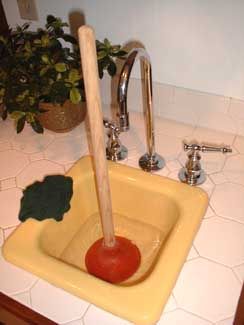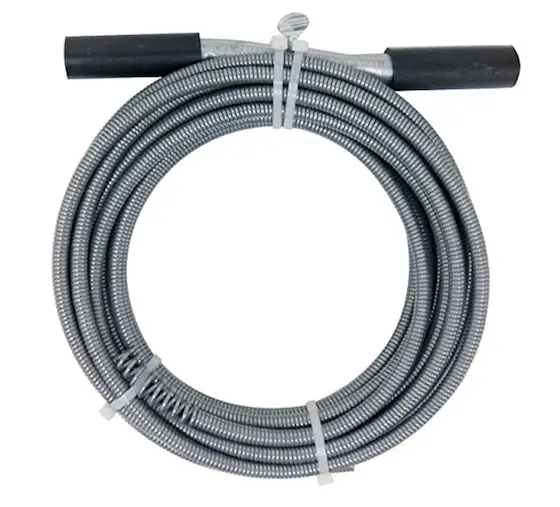Clogged Drain Hack

Clogged Drain Hack TIPS
- Some pro drain cleaning companies offer no-clog warranties
- Older drain pipes can have ROUGH interior surfaces
- Five gallons of water in a toilet bowl FAST can remove clog
- Prevent clogs by putting lots of water through pipes fast
- CLICK HERE to Get Tim's FREE & FUNNY Newsletter!
DEAR TIM: I love my plumber but I am getting sick and tired of paying him to unclog my drains. Do all household drain lines clog?
Do plungers really work that well? Are there things I can do to prevent clogs? Sandy R., Hoquiam, WA
DEAR SANDY: Calling a plumber or a drain cleaning company each time you get a clog can indeed be expensive.
Some Pros Offer Warranties!
But keep in mind that some plumbers and drain cleaning companies offer a limited warranty on their work. If a drain stops up again within a specific time period, you do not have to pay to have them come back out.
Get this warranty in writing if you do find that you need professional help in the future.
Free & Fast BIDS
Every drain line in every house is susceptible to clogging. Certain drain-pipe materials, plumbing codes and excellent plumbing practices can keep clogs to a minimum, but few homeowners ever have the opportunity to specify the piping material and possess the knowledge to determine if a plumbing drainage system has been installed to the highest levels of workmanship.
PVC Is Smooth
PVC plastic and copper drain lines have very smooth interior surfaces. These are least likely to clog. But they can and do clog!
Not too long ago I had to clear a clog in my own home. The building drain pipe under my basement floor is PVC.
The source of the clog was a new low-flush toilet. I'm not a fan of these. This particular toilet only sends two quarts of water down the drain if you flip the flush handle.
To get the entire 1.6 gallons of water out of the toilet tank, you have to hold down the flush handle for five seconds. That's a very poor design because the average homeowner would never know to do that, nor want to stand there holding down the flush handle.
My son and wife were not doing that and about thirty feet away from the toilet, a giant buildup of toilet paper clogged the drain.
It took a while, about one year, for the drain line to completely get clogged with a mass of toilet paper and other solid you-know-what.
I was able to get it cleared with ease using a 50-foot hand-powered drain cleaning snake. Once I put the snake in the clean out opening I had the clog removed in about ten seconds.

Here's the exact simple drain cleaning snake I used to clear my clog. CLICK THE IMAGE NOW TO HAVE THIS DELIVERED TO YOUR HOME.
Galvanized & Cast Iron Rougher
Older homes often have drain pipes made with galvanized or cast iron pipe. Smaller diameter drain lines made with these materials are prone to blockages.
The galvanized and cast iron drain lines over time begin to corrode from the inside out. A scale of rust and corrosion creates a very rough inner surface that helps to grab hair, toothpaste, soap film, etc. Soon the inner diameter of the drain pipes begins to get smaller.
I have seen some 1.5 inch inner diameter drain lines packed solid with rust, scale and black organic goop and biofilm.
5-Gallon Bucket HACK
Many common toilet clogs can be removed with just a five-gallon bucket of water. Some clogs in toilets allow water to slowly get past the clog. You'll flush the toilet, the water will rise to the top of the bowl and either overflow - a HUGE MESS - or it will stop just in time.
Then ten minutes later you'll notice the water level in the bowl has magically dropped to the normal level. But don't be fooled, the clog could still be there because the water seeps past the toilet paper in the clog.
Force = Mass X Acceleration
Ninety percent of the time if you have a clog like this, you can free it with five gallons of water. Fill a bucket and hold it up about 18 inches from the toilet bowl.
Pour it as FAST AS POSSIBLE into the bowl and stop pouring just as the water rises to the rim of the bowl. The weight of the water falling that distance and lots of it at once put lots of pressure against the clog. In almost all cases, it's enough to unclog the toilet. No need for the messy plunger!
Plungers Work Well
Plungers do work very well if you use them properly. They should be the first tool one uses when a clog happens. It's important that the bottom of the plunger make full contact with the fixture so the pressure you create when plunging is forced down the pipe.
If the plunger seal is inadequate all the pressure will just be in the sink or toilet and wasted.
Remove Stopper From Tubs
When you are working on a tub or bathroom sink drain, you tend to get the best results if you remove the stopper mechanism from the drain inlet. To remove a sink stopper, you must remove the control rod that connects to the stopper and sticks out the back of the pipe that exits the bottom of the sink.
Reinstall the control rod and nut into the pipe after the stopper has been pulled up from the sink. Tub drain stoppers typically are attached to the lever on the overflow outlet. Remove the two screws at this location and pull up to remove the lever and the tub stopper.
Hair & Goop
Often hair and goop will be on the end of the control rod and the bottom of the stopper. This alone may be the source of the problem. If the drain is still clogged, take a wet wash rag and hold it over the drain overflow holes at the top front edge of the sink.
Run water so that you have about two inches of water in the sink, hold the rag tightly against the overflow holes and push hard down on the plunger two or three times. Remove the plunger to see if the clog was dislodged.
If you're lucky, you will experience instant improvement. Water will flow readily from the sink or tub. If plunging does no good, it may be time to try some of the off-the-shelf drain cleaners and/or call in a professional.
Clog Prevention
You can prevent clogged drains by performing some very simple tasks on a routine basis. Check the sink and tub stoppers on a quarterly basis for hair and biofim buildup.
It is easy to remove and replace these items. Once a week, fill each sink in your home to the brim and then pull up the stopper. The volume and weight of the water will fill the drain pipe completely with water. It will do a good job of flushing the drain line.
Once a week pour five gallons of water as fast as possible into a toilet to give the drain line a great clean out.
Three-Month Huge Flush
Once every three months fill every sink and tub in the house with water. With the help of friends or family members simultaneously pull all of the drain stoppers up and flush all toilets in the house. This large volume of water will help flush out the larger sized drain stacks and underground building drains.
Chlorine Bleach - Great Drain Cleaner
If your home is connected to a municipal sewage plant, you can really help your drain lines if you pour liquid chlorine bleach into the fixture traps once a month. Pour 12 ounces of bleach into each sink and tub before you go to bed.
Pour it carefully into the drain of stainless steel kitchen sinks. Chlorine bleach that lays on stainless steel can cause permanent stains. The chlorine bleach that sits in the trap and saturates partially clogged drain lines works to soften biofilm and debris overnight. When you use the fixtures the next day, water running through the drain lines carries the debris to the sewer.
Column 454
14 Responses to Clogged Drain Hack